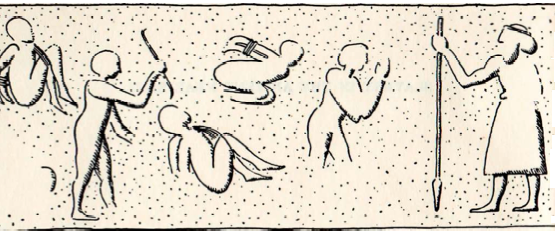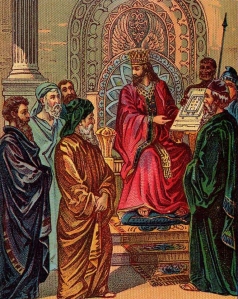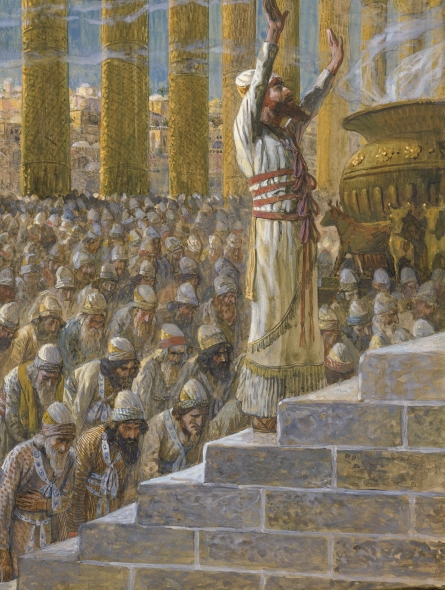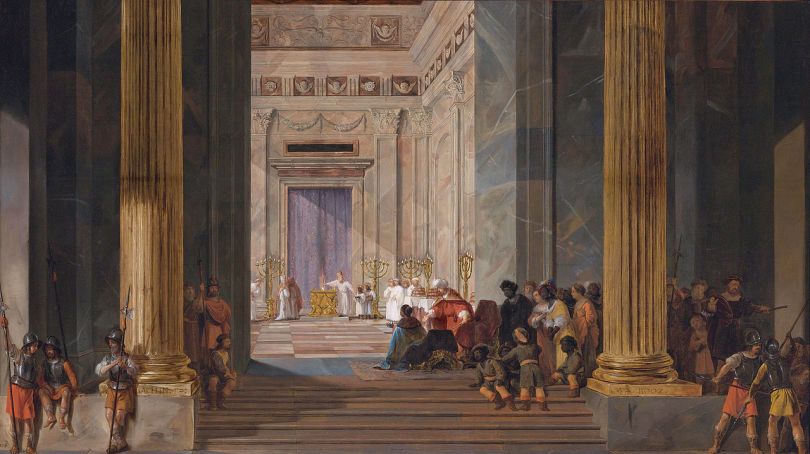Discussions about slavery in the Bible tend to focus on the treatment of slaves in the Jewish law as described in the Pentateuch. These passages, however, concern only private ownership of slaves. In the Ancient Near East, the institution of slavery was present in three different domains that were legally distinct: private slavery, state slavery, and temple slavery. Whether the Bible described and condoned slavery in the context of the Jerusalem temple and religious practices is a topic I had not encountered until recently.
Slavery in the Ancient World: A Brief Summary
The practice of slavery goes back to prehistoric times, but became particularly widespread on an institutional level with the establishment of bureaucratic states in the Bronze and Iron Ages. Slaves were acquired primarily through the enslavement of war captives and through the dedication of children by individuals—especially impoverished parents who could not support their children. Other slave-like forms of servitude included debt-slavery and corvée labour, which are mostly beyond the scope of this post.
In addition to privately owned household slaves, the use of slaves was a widespread practice of the state. In Babylonia, Assyria, and other nations, war captives would become the property of the king and be put to use as forced labour on civil works projects or in mines and factories owned by the palace. This practice was also maintained by the smaller city-states of Syria and Palestine.

Yet another institution that made use of slavery was the temple. In ancient Mesopotamia, temples were the largest and most powerful industrial and commercial entities in the country.¹ They controlled extensive tracts of land, industrial enterprises, flocks of cattle and sheep, sizeable amounts of precious metals, and large numbers of slaves. We have fewer sources on Syrian and Palestinian temples, but they seem to have played similar roles in their societies. The Bible, for example, frequently mentions the treasury of the temple in Jerusalem, which must have possessed great wealth and exerted significant economic influence in Judah.
The temple labour system in place during the Neo-Babylonian period is thought to have particular relevance for Israelite practices. The temple of Ishtar possessed a class of hereditary slaves known as Sirqu, who were responsible for carrying out various tasks for the temple—particularly menial labour. They could perform agricultural and commercial work as well, though freeborn tenants and artisans were typically hired for these purposes.²
These temple slaves were not governed by the regular slavery laws, which allowed manumission under certain circumstances and ensured the freedom of children born to one non-slave parent. This might be because their “master” was believed to be the god or goddess of the temple, rather than a human owner.³ The Sirqu were slaves in perpetuity; their children and their children’s children would never be allowed their freedom, even if they married free citizens. Temple slaves like the Sirqu were also treated more harshly than privately owned slaves, and infringements of any kind were severely punished.

Can we find evidence of such practices in the Bible as well? Did the priests of Yahweh’s temple in Jerusalem (or at other religious sanctuaries) own and use slaves?
Donations of Slaves to the Temple as War Booty
Numbers 31 describes an attack on Midian by the Israelites under Moses. A portion of the spoils, consisting of both physical wealth and captives, is given to the “temple”, here represented by the Levites and the tabernacle:
From the Israelites’ half Moses took one of every fifty, both of persons and of animals, and gave them to the Levites who had charge of the tabernacle of Yahweh; as Yahweh had commanded Moses. (Numbers 31:47)
The exact purpose of these slaves is not specified. However, the fact that only female virgins were left alive to be apportioned out as war booty implies that their duties would have been sexual in nature.
The Enslavement of the Hivites
Joshua 9 tells how the Hivites of Gibeon hear of “what Joshua had done” to Jericho and Ai, mercilessly slaughtering their inhabitants in accordance with the command of Deuteronomy 20:10–18, which says that all towns in the promised land (including the Hivites) shall be subjected to herem, ritualistic slaughter. According to the same passage, towns outside that geographical area may submit and be subjected to slavery instead of death. Of course, the Gibeonites haven’t read the command in Deuteronomy, but it suffices that the reader has.
The clever Hivites here decide to save themselves by meeting Joshua disguised as travellers from a distant region, and by doing so, they are able to secure a peace treaty with Israel. When Joshua finds out they actually live nearby, he is prevented from killing them by the treaty and oath sworn by the Israelites; so instead, he forces them to become slaves of “the house of God”:
Joshua summoned them, and said to them, “Why did you deceive us, saying, ‘We are very far from you,’ while in fact you are living among us? Now therefore you are cursed, and some of you shall always be slaves, hewers of wood and drawers of water for the house of my God.” … This is what he did for them: he saved them from the Israelites; and they did not kill them. But on that day Joshua made them hewers of wood and drawers of water for the congregation and for the altar of Yahweh, to continue to this day, in the place that he should choose. (Joshua 9:22–27)
This story is often taken to be an etiological tale that explains why a certain group of people was subservient to the Israelites. (It cannot be a historically accurate account for several reasons, including the ahistorical nature of the Canaanite conquest itself and the fact that Gibeon was not inhabited during the late Bronze Age.)⁴ In particular, this group seems to have been enslaved to serve whatever temple or sanctuary existed in the writer’s own day, since the language “you shall always be slaves” and “continue to this day” suggests that the writer has the current situation in mind.
In fact, we can say with confidence that it was probably the Jerusalem temple where these slaves served. As John Day states in a recent article:
Deuteronomistic terminology is clearly detectable in the phrase ‘the place which he should choose’, and since for the Deuteronomists at the time of writing this would have been the Jerusalem Temple, it follows that the Gibeonites were understood to have been incorporated within that sanctuary to perform menial cultic tasks.⁵
It was widely understood even in Talmudic times that the Gibeonites were to be identified as the Netinim, a hereditary class of servants/slaves as we shall see below. According to the Talmud (Yebamot 78b–79a), Joshua “appointed them for the times when the Temple would stand”. This identification is generally accepted by scholars.
King Solomon’s Slaves
Slavery features prominently in the acts of King Solomon as depicted in the Bible — particularly in the building of the temple itself. 1 Kings 5 describes a massive campaign involving forced labour during its construction:

King Solomon conscripted forced labor out of all Israel; the levy numbered thirty thousand men. He sent them to the Lebanon, ten thousand a month in shifts; they would be a month in the Lebanon and two months at home; Adoniram was in charge of the forced labor. (1 Kings 5:13–14)
What we are dealing here is not chattel slavery, but corvée slavery — the “right” of the king to force his subjects into mandatory labour as a sort of taxation for public works and other projects.
Later on, we are also told that Solomon forced slavery on all remaining non-Israelites in the country:
All the people who were left of the Amorites, the Hittites, the Perizzites, the Hivites, and the Jebusites, who were not of the people of Israel — their descendants who were still left in the land, whom the Israelites were unable to destroy completely —these Solomon conscripted for slave labor, and so they are to this day. (1 Kings 9:20–21)
Again, we get the sense that the Deuteronomist writer (one of whose trademarks is that laundry list of foreign nationalities) is explaining the origin of certain subjugated classes in his own day. The next verse reads, “But of the Israelites Solomon made no slaves.” This reinforces the interpretation that these foreigner-derived slaves were absolute slaves (mas ‘obed in Hebrew), and not temporary corvée slaves (mas in Hebrew) like the Israelites of 1 Kings 5.⁶ It would appear that these slaves were put to work specifically in Solomon’s temple, as we shall see below.

The Netinim and the Second Temple
There is a class of temple functionaries called the Netinim (or Nethinim) mentioned once in Chronicles and several times in Ezra-Nehemiah. As mentioned earlier, this group is widely thought to have been comprised of temple slaves whose origins were explained by the story in Joshua 9. Long lists of their family names appear in three related scriptural texts: Ezra 2, Nehemiah 7, and 1 Esdras 5. What is notable about these names is that they are nearly all non-Hebrew names.⁷ Their placement in the list of returnee groups (e.g. after the priests, Levites, gatekeepers, and singers in Nehemiah 10:28) also suggests they were more lowly in status. The fact that a class of non-Israelites served in the Temple is further confirmed by this passage in Ezekiel, which sees their presence as an affront to God:
Say to the rebellious house, to the house of Israel, Thus says the Lord God: O house of Israel, let there be an end to all your abominations in admitting foreigners, uncircumcised in heart and flesh, to be in my sanctuary, profaning my temple when you offer to me my food, the fat and the blood. You have broken my covenant with all your abominations. And you have not kept charge of my sacred offerings; but you have appointed foreigners to act for you in keeping my charge in my sanctuary. (Ezekiel 44:6–8)
Other striking parallels between the Netinim and the Babylonian Sirqu caste have been noted, including the fact that both were housed in their own sections of the city. The term that Josephus used for the Netinim, hierodouloi or “sacred slaves”, has also been marshalled as evidence that the Netinim were temple slaves during the Second Temple era.⁸ Esdras B 8:20 (the Greek translation of Ezra-Nehemiah) explicitly states that the Netinim were those “whom David and his rulers had given into slavery to the Levites.”
Some scholars (notably Baruch Levine) disagree that the Netinim were slaves rather than merely temple servants and functionaries.⁹ However, the general consensus seems to be that the Netinim originated as a caste of non-Hebrew hereditary temple slaves before the exile who remained in that vocation afterward, whether as freeborn citizens or not. (The possibility that they gained their freedom from the Babylonian conquest is not without irony.)
It is difficult to say how late the Netinim persisted as members of the temple community. There are some mentions among the Dead Sea Scrolls, suggesting (at least to me) that it was not merely a short-lived group of the Persian period.
The Sons of Solomon’s Servants
Ezra, Nehemiah, and 1 Esdras mention another group immediately after the Netinim: the “Sons of Solomon’s Servants”. This group is even more obscure than the Netinim, but it seems to consist of servants or slaves descended from “Solomon’s Servants”, who are to be equated with the foreigners enslaved in 1 Kings 9. What’s more, like the Netinim, their names seem to be mainly non-Israelite in origin. It may be that this group consisted of palace slaves during pre-exilic times but became low-level servants of the temple later on (when there was no longer a Judahite state).10
Other Complications
The texts employed as evidence here — Joshua, 1 Kings, Ezra-Nehemiah, and 1 Esdras — have complicated histories of authorship and redaction, as well as unclear literary relationships to each other (particular in the case of Ezra, Nehemiah, and 1 Esdras) and uncertain dates of origin. However, it seems difficult to deny the picture that emerges when all relevant biblical passages and general historical knowledge are taken into account:
- The Jerusalem temple very likely functioned as a slave-holding institution before the exile.
- The slave caste consisted mainly of non-Hebrew families, as one would expect from the manner in which slaves were acquired in the ANE.
- Two of the major groups involved with post-exilic temple were understood, at least in Talmudic times if not earlier, to be descendants of the pre-exilic slave castes.
- These groups retained their identity as non-Hebrews and were disdained in some quarters, particularly by the Zadokites and some members of the Qumran community.
Footnotes
-
I. Mendelsohn, Slavery in the Ancient Near East, Greenwood Press, 1978, pp. 99–100.
-
I. Mendelsohn, “Slavery in the Ancient Near East” The Biblical Archaeologist, 9(4), 1946, pp. 86–87.
-
Keith Bradley and Paul Cartledge, eds., The Cambridge World History of Slavery Volume I: The Ancient Mediterranean World, p. 15.
-
Patrick M. Arnold, “Gibeon”, Anchor Bible Dictionary.
-
John Day, “Gibeon and the Gibeonites in the Old Testament”, Reflection and Refraction: Studies in Biblical Historiography in Honour of a. Graeme Auld (SVT Vol. 113), 2006, p. 134.
-
Menahem Haran, “The Gibeonites, the Nethinim and the Sons of Solomon’s Servants”, Vetus Testamentum 11(2), 1961.
-
Ran Zadok, “Notes on the Biblical and Extra-Biblical Onomasticon”, The Jewish Quarterly Review (New Series), 71(2), 1980.
-
Joseph P. Healey, “Nethinim”, ABD.
-
Levine, “The Netînîm”, JBL 82(2), 1963.
-
Healey, “Solomon’s Servants”, ABD.

[…] Discussions about slavery in the Bible tend to focus on the treatment of slaves in the Jewish law as described in the Pentateuch. These passages, however, concern only private ownership of slaves. [Read more] […]
LikeLike
[…] According to Paul Davidson of Is That In The Bible?, it appears that Gibeon was not inhabited during the late Bronze […]
LikeLike
[…] Davidson has a great discussion about the various forms of slavery in the Bible that doesn’t fall under the category of […]
LikeLike
What’s interesting is that Deuteronomy 20:18 states that the reason that nations residing in Canaan had to be killed is because if those inhabitants were left alive, they would “teach [the Israelites] to do all the abhorrent things that they do for their gods, and [the Israelites would] thus sin against Yahweh [their] God.” Are we to assume that people outside the “Promised Land” were all Yahweh-worshiping folks who would never think of enticing the Israelites to worship another god? And there is not one hint that the residents of Gibeon, a place that is described as a “large city” where “all its men were warriors” (Joshua 10:2), ever attempted a revolt against Israel or led the Israelites into apostasy, which belies the reasons usually posited for the necessity of killing all Canaanites.
LikeLiked by 1 person
Yeah, the right/obligation to eliminate all non-Israelite ethnicities within the Promised Land has obvious propagandistic undertones in the deuteronomistic narrative, even though it doesn’t really correspond to any historical reality and can be altered when necessary, such as the survival of the Hivites as slaves of the temple.
LikeLike